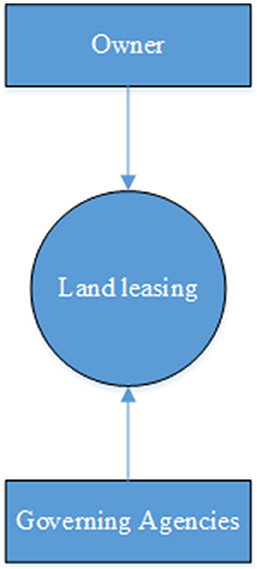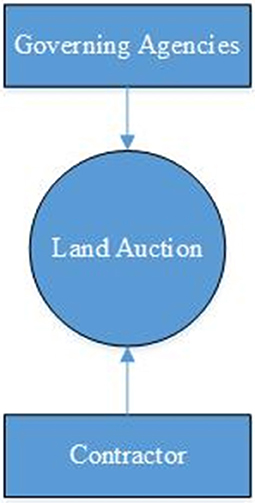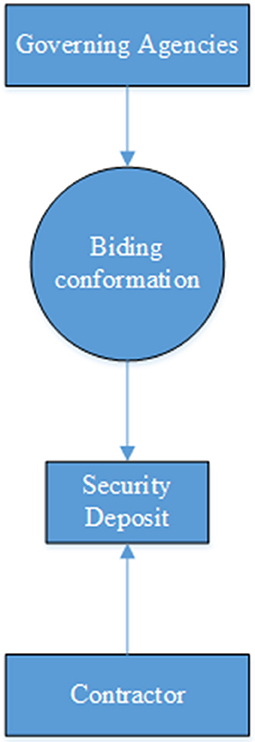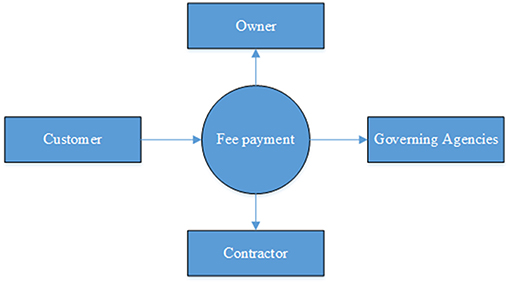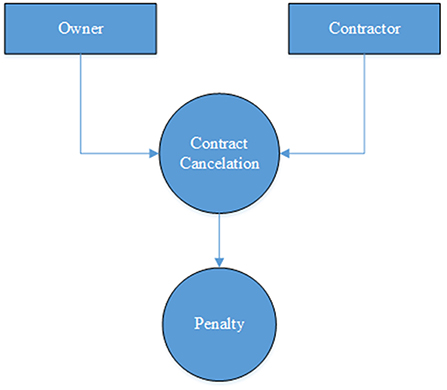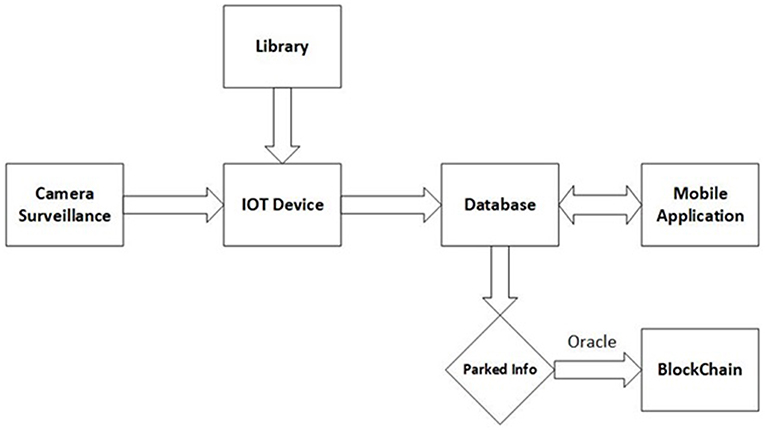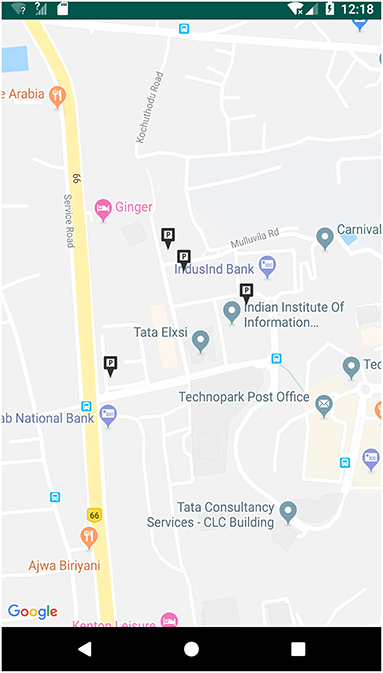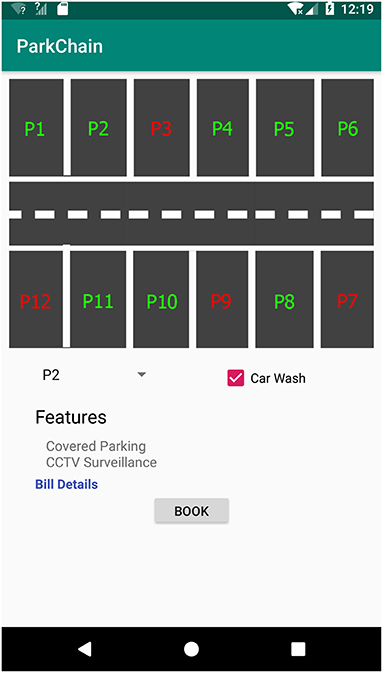- 1Faculty of Technology, Indian Institute of Information Technology and Management-Kerala, Thiruvananthapuram, India
- 2Faculty of Technology, Cochin University of Science and Technology, Kochi, India
With the advances happening in the area of urbanization, with increased demand for dwellings and an increased number of vehicles on road, finding a parking spot has become one of the major pain points for the citizens. This is mainly due to the limited parking spaces available and difficulty in finding a vacant lot during busy hours. To overcome this limitation, one solution is to create smart parking spaces which are rather easier to find and use. In this work, we propose a Blockchain based solution where parking pools can be created by developing a transparent platform where individuals can rent out their unused land for a stipulated amount of time. A non-fungible token system representing unique parking lots will be created for transparency of the entire system. This also has the added advantage of generating revenue from their otherwise unused property. Smart contracts over Blockchain enforce the contractual agreement between the participants ensuring financial transparency in the proposed system.
1. Introduction
With the ongoing urbanization process, parking has become one major pain for the citizens due to the limited parking spaces available in the cities (Wang, 2011). One solution is to build multi-level parking infrastructure so that more cars can be parked in a given land area. This is a better-voted solution but the major drawback is the huge infrastructural investment and the ongoing maintenance (Lu et al., 2009). Another option to reduce the parking crisis is to encourage people to use public conveyance such as buses, rail transport, metro, etc. However, in developing countries, public transportation may not be great and may not have deep penetration near the outskirts. Therefore, if we can create smart parking spaces with better usability, people can save their time and money by conserving gasoline wastage and time to find a parking lot along with reduced emissions. This would also reduce congestion on roads (Zheng et al., 2015; Biswas and Muthukkumarasamy, 2016; Kotb et al., 2017).
In general, there is the availability of private owned unused land in every locality. If some of these lands can be utilized for creating smart parking pools, the intensity of vehicle congestion on roads searching for a vacant lot can be mitigated (Rico et al., 2013). Challenges in releasing these properties for leasing or rental are the legal complications owners will have to undergo, when they want the possession of their land back, before or after the expiry of leasing contract. In this work, we propose a Blockchain powered smart contract based solution using IoT for leasing the property for creating parking pools (Khanna and Anand, 2016). This smart platform could be extended to existing parking pools to provide smart service to the end users as well as to build a transparent revenue model for their rental business. Smart contracts ensure the enforcement of contractual conditions such that the participating agents are exempted from the legal complication involved in the process by building an immutable audit trail in Blockchain. An affordable parking ecosystem built up using this approach will be a win-win scenario for the public, government, landowner, and the contractor. The landowner will get returns from his land without any capital investment with the surety of his ownership over the property. This crowd-sourced parking solution approach will leverage governments to set up enough infrastructure with little investment. The contracting agency managing the business will generate revenue from the vehicular parking and profit will be shared with the landowner and the government agency according to the contractual agreement. Operation cost and other recurring costs for managing the park chain will be met from incoming revenue. This solution could be extended to accommodate currently existing parking pools to migrate into the proposed Blockchain framework.
The proposed system is primarily a multi-agent system where the primary player is the governing body of the state. This governmental body will be responsible for linking the landowner and the sub-leasing agent and setting up the contractual conditions between the leasing party and the contracting parties. Multi-party consensus mechanism, say complete voting approach, is built on top of Blockchain powered smart contracts. Smart contracts ensure and enforce the terms and conditions along with the tenure of the leased property and the pricing options to be exercised during the lease period, revenue sharing contracts, etc. Terms and conditions including but not limited to the tenure of the lease period, the penalty for pre-term withdrawal of the leased property, security deposit by the contracting agencies, agreement for pre-term closure of the parking area by contacting party. The leased lands will be converted into digital assets using non-fungible token (Entriken et al., 2018) and can be traded over the public ledger mechanism of Blockchain.
1.1. Motivation
Parking, especially in city areas is a continuous struggle due to the acute space constraints (Ferreira et al., 2018). People have to travel large distances in search of parking spaces in a crowded locality. Also, an increasing number of residential apartments demands an increased parking requirement. Close knit, thickly populated residential colonies or areas finds guest parking nearly impossible or have to park along the roadsides, making roads congested. Parking demands will be high on weekends near shopping malls, beaches, and parks. On weekdays parking near official building premises by employees and their clients will be too huge. They end up losing unnecessary time and money for a journey in search of parking and due to congested road (Polycarpou et al., 2013). Huge traffic congestion in the cities can be mitigated by providing enough parking spaces. With a smart parking solution in place, the public will be pleased to park their vehicles within the vicinity securely and to meet their day to day needs. We propose a smart solution (Tsaramirsis et al., 2016) based on IoT and Blockchain smart contracts to create parking pools with crowdsourcing concept, with private individuals having unused land willing to lease the land for a stipulated amount of time. Other participating parties include contracting agencies to run and manage the parking area, law enforcing governmental bodies, public people availing the parking facility, etc. The proposed solution offers the added benefit of making greener cities, with lesser emission, reduced traffic congestion, shorter travel time, generating revenue with little investment, improved and efficient city life and to build a transparent partnership between landowners, parking-enforcement agencies, citizens, local businesses, etc (Klappenecker et al., 2014).
1.2. Why Blockchain?
Blockchain is a distributed ledger technology that uses a consensus mechanism enabling trust, transparency, and immutability of data (Swan, 2015) among the participants. It is a decentralized network of nodes working together to validate transactions by solving complex computationally intensive tasks. This technology eliminates the need for a trusted third party by allowing users to sign contracts electronically verifying them as valid and legal. It brings in the concept of decentralized consensus, thus eliminating the need for a central authority. The Blockchain is essentially a chain of blocks that contains the data of all transactions within a period of time, and a reference to the block before it. The cryptography that goes into creating a block differs depending on which Blockchain protocol is used, but typically one can traverse through the entire Blockchain and every single transaction ever made, all the way back to the first one, called genesis block. Hashing algorithms are used to make sure that all blocks are well formed and not tampered with, and thus the Blockchain keeps itself secure and virtually unchangeable. The decentralized nature of Blockchain along with the consensus mechanism can be used to enable a land leasing system for parking lots powered by smart contracts. This paper proposes a system to leverage unused land for parking and enforces leasing agreements through smart contracts.
This non-fungible token system avoids discrepancies or disputes in land usage patterns and ensures fair distribution of income to all the involved stakeholders. Eventually, this will promote small households to large corporates to build a new revenue model over their under utilized resources.
1.2.1. Why Smart Contracts?
Smart Contracts provide a decentralized, cheaper, secure and verifiable mechanism on the Blockchain to use the private land area for parking vehicles. Ethereum is a programmable public Blockchain technology developed on the basis of much-hyped crypto-currency termed bitcoin (Nakamoto, 2009). Ethereum supports the conversion of physical or legal contracts into self-executing digitalized formats called smart contracts, which are enforceable rules on Blockchain. Ethereum Virtual machine is a decentralized virtual machine that supports a Turing complete programming language.
The Ethereum Blockchain allows user-created digital smart contracts to be executed by implementing a generically programmable code (Buterin, 2014). It is not solely a network for exchanging cryptocurrencies but a network where transactions can be used to execute an unlimited number of self-developed smart contracts. This Blockchain serves as the back-end of decentralized applications, which can be as different as voting systems, domain name registries, financial exchanges, confounding platforms, company governance, or intellectual property such as music songs. The Ethereum Blockchain solution allows everyone to write smart contracts resulting in decentralized applications where it is possible to build your own arbitrary rules for ownership, transaction formats, and state transition functions.
2. Related Works
Existing parking solutions like Parkgene1, developed by PARKGURU Group, offers a Blockchain as a service-based platform using cryptocurrency (tokens and wallets) to transact the parking lot between the owners and the end users. In this approach, the land-owner should shoulder the whole burden of setting up the parking space. The owner can rent out space through the park gene platform and generate revenue out of it. In another parking application termed Parkaide2, provides a smartphone based application for parking space booking with no ticketing. The mobile app has the option to choose the car park of your convenience. After choosing which car park and based on the duration of the stay one can make payment through a token method and you can avail the parking lot for the allocated time. Parkaidapp3 is an augmented reality-based platform that shows the available parking slot and other details of street parking using the crowdsourcing concept.
However, in Parkchain, we use ERC-721 tokens generated by the system to create non-fungible tokens to uniquely identify each parking lot. These system generated tokens out of owner registered land will be transferred to the owner's wallet. After successful bidding(through auction offline process) of the parking lots by the contractor, the winning contractor will receive these tokens in their wallet. The token id will be persisted in Blockchain, each time the corresponding slot is rented out. Incentivization of the lending parking space is through the exchange of fiat currency through the integrated payment gateway (PhonePe, google pay, UPI, Amazon pay, etc) in the mobile application. Though this system has similarities with other parking solutions, managed by private parties, this solution has advantages like governmental involvement, a lesser burden on the landowner in setting up parking space, etc.
3. Preliminaries and Assumptions
3.1. Challenges and Risks of Using Blockchain and Smart Contracts
For the time being, the transaction of cryptocurrency as a financial or monitory tool is illegal by law in a country like India. There is a lot of confusion revolving around whether cryptocurrencies can be treated as a non-monetary reflection for a smart contract, similar to Commodities Futures Trading Commission recognizing bitcoin or ethereum cryptocurrency as a commodity and taxing it accordingly. Currently, there is no clear cut answer regarding how the smart contracts shall be legalized in the Indian Law. Another challenge is that the Blockchain and smart contacts is in its infancy stage and has to face both technical and legal challenges. Ethereum doesn't provide the privacy on the transaction records along and it is buggy nature. However, with the current momentum of research and developments happening in the Blockchain domain, would help the technology to mature with time and address these issues. For a country like India, where regulatory concerns exist, a large scale adoption of the technology would require the government to make amendments to the Indian Evidence Act, 1872 and the IT Act to include the regulation and legalization with respect to the finer details connecting to smart contracts. Until then a solution for all disputes arising out of the system will be addressed outside Blockchain.
Even though running smart contract on Ethereum platform needs some expense in terms of gas value, this eliminates the chances of the cost incurred over settling disputes and discrepancies and can recover the initial expenses in the long run. Moreover, new Ethereum updates like Constantinople reduce the gas cost of smart contracts considerably for mainstream adoption. This triggers a positive sign for implementing cost-effective smart contracts over public blockchain with lesser expenses when compared to physical contracts.
Park tokens created using ERC 721 non-fungible token standards will be made available to the stakeholders through mobile wallets. The token generation and issuance will be taken care of by the system and will be made available to the user through a simple mobile application integrated with the payment gateway. Users can make the payments through this application and transact for the park tokens to make use of the parking lots.
Currently, there is an ongoing study being carried out by the government in bringing Blockchain as a non-financial solution provider4. Applications like “Bank chain” by State Bank of India (India's largest bank) is a perfect example of seeking Blockchain as a solution platform for information exchange and sharing. Active projects in Bankchain includes KYC / AML, syndication of loans/consortium lending, trade finance, asset registry and asset re-hypothecation, secure documents, cross border payments, peer-to-peer payments, and Blockchain security controls. Though the regulatory measures are yet to be accepted or amended in India, for accepting Blockchains and smart contracts, lot of measures are currently being studied and implemented to bring applications and platforms using it to Indian ecosystem like land-registry in Hyderabad5, birth certificate issuance through Blockchain in Kolkata, Amaravathi, Chattisgargh, and Maharashtra6. The Finance Minister in his Budget Speech marked India is all set to explore the use of Blockchain technology for the improvement and betterment in the digital economy. In short, the legalization and regulation measures using Blockchain and smart contracts is in pipeline, and it is just a matter of time for the amendment of the rules.
3.2. Blockchain Environment
Blockchains can be broadly classified as: Public, Private, and Consortium Blockchains.
3.2.1. Public Blockchains
Public Blockchains are accessible to anyone without restrictions and any node can take part in the consensus process (Zheng et al., 2017). The consensus process determines which transactions get added to the Blockchain and maintains the current state of the system. Public Blockchain is decentralized meaning no single entity has control over the network.
3.2.2. Private Blockchains
These are Blockchain systems that are maintained by an individual or organization and is not accessible to the general public. In the private Blockchain, transaction validations are performed by a single centralized authority.
3.2.3. Consortium Blockchains
These Blockchains are controlled by a group of institutions who owns a pre-selected number of nodes. These Blockchain can be considered partially decentralized (Lin et al., 2017).
A parking leasing system using Blockchains is best implemented using a Consortium Blockchain. But for demo purposes, this work uses a private Ethereum Blockchain created using Geth(Go-ethereum). The smart contracts are written using solidity programming language (Dannen, 2017). This system uses a development environment called Truffle for package management and smart contract deployment onto the Blockchain.
In this proposed work, the responsibility of setting up the parking lot and meeting the expense toward it is not vested with the landowner but lies with the contractor. The objective of this work is not for commercializing tokens for crypto exchanges but for implementing a solution for the public good with proper government intervention. With the Blockchain backed infrastructure, the three parties build the ecosystem where any customer can loan the lot, and the generating revenue after meeting the maintenance costs and other recurring expenses, will be shared among the stakeholders. As the contractor is making the initial investment, a two-stage revenue sharing policy is proposed, that could be fair and motivating for the contractors. The first stage where the major share of the revenue would go to the contractor until he/she meets his initial investment. The distributed ledger will keep track of payments and smart contract ensures appropriate revenue share between stakeholders. This is done based on the off-line bidding and initial investment details came through the oracle, the contractor can request the system to create a verifiable claim, which will be managed through smart contracts. The second stage follows significant revenue income for the landowner. For the PoC implementation we realized this with 65, 25, and 10 percentage split of the revenue generated among the contractor, owner and government respectively. For the second stage we kept the formula as 50, 40, 10 percentage of the incoming revenue after meeting the running cost. These inputs(running cost, initial investment etc) could come from an oracle, based on the bidding (off-line) process.
Land registry process for the verification of land title by the property owner is considered to be carried out outside the box. Figure 1 shows the external modules assumed to be integrated into the proposed system.
3.3. Proposed System
This paper introduces a system that uses non-fungible parking tokens for creating digital assets equivalent to unused land for setting up a smart parking pool. The Blockchain infrastructure can provide the trust, transparency and immutable traceability required for leasing the unused parking lot. This paper suggests developing an audit-able system that operates using smart contracts ensuring legal and financial transparency with the following actors such as Legal Agency(government), Land Owner, Contractor, Customers, etc (Figure 2).
4. Technology Integration
Any individual who possesses vacant land suitable for parking can register in the park-chain through government validated process and procedures. The system will evaluate the ownership and location of the property and generates approvals for parking lots to the landowner based on the inputs from the oracle through external systems integrated. In Blockchain, Oracle is a third party agent that provides verified information to blockchain to be used by smart-contracts. For the certified owners, the system generates non-fungible park tokens from the park-chain which can be bid/lease by the contractors for a stipulated time period. Once the bid is finalized, it is legalized through a smart contract approved by all the stakeholders. A complete voting mechanism is used as the trigger for the deployment of the smart contract. Smart contract relations are depicted through Figures 3–7.
ParkChain assumes an explicit external ecosystem integrated to the Blockchain platform using Oracle as shown in Figure 1. The external system is responsible for the verification of land title and ownership related details. The detailed operation of this module is outside the scope of this work. Regarding the token issue for the owners and contractors, it is assumed that the government will manage the technology platform and contractors need not run or manage any applications explicitly. However, they will be able to monitor the system through wallet addresses and through exposed APIs or mobile applications. The same is the case with the end customers, where they use the mobile application to book the parking lot and to make payment. The integrated system manages the token creation for the landowners and leasing it out by transferring it to the contractors' wallet account. This is detailed in the block diagram shown in Figure 8.
Working on video surveillance in the Park chain is shown in Figure 8. The components of the system such as Camera Surveillance, edge device, a python library for image processing, is briefly explained below.
1. Camera Surveillance unit: This is installed at every parking pool and is connected to an IoT device. The camera surveillance unit captures and sends the images to the IoT device. This unit mainly focuses on obtaining images for monitoring the parking space.
2. IoT unit: This is a mini computer board which obtains images from the camera surveillance unit and gets inputs processed using the python library. IoT unit analyses the images and obtains the list of empty and occupied parking spaces with respect to a time stamp.
3. Python Library: This is an image processing software used for analyzing the images obtained by the camera unit. This unit functions to enable image processing for the occupancy of the lots in a parking pool.
4. Database: This is a traditional MySQL database unit that stores the parking data obtained from the IoT device. The database schema consists of 1. Parking Id 2.Parking lot id 3.status (EMPTY, OCCUPIED, BOOKED, ILLEGAL) 4. Timestamp.
5. Mobile Application: This is the mobile application used by the customers who want to view and book available parking spots (Figures 9 and 10). Payment gateway integration is done with fiat mode of payments for the bookings made.
6. Blockchain: Only the important details such as parking data are sent from the database through an Oracle to the Blockchain. Oracles connect the traditional database with the Blockchain system. Blockchain also manages the transactions of ERC -721 tokens between the owners, contractors, and customers.
In this work, we assume an external system interfaced with the proposed Parkchain. Oracles are used to interface the external system as well as the surveillance system to Parkchain. The details of the external system are shown in Figure 1 and the modules are explained below.
1. Land Registry: The details of the ownership of parking lot are obtained from the government land department. One way content hashing is used to uniquely identify land registry values. This is an external system to the proposed Parkchain.
2. Government mandate external system: This is the system that verifies the land title, ownership and checks whether the land is suitable for parking, road access, security, and other aspects. It also checks whether there are adequate facilities available for functioning as a parking lot.
3. Token Letter of Credit: This is the ERC 721 token defined to uniquely identify each parking lot. Here the token is based on the letter of credit provided by a bank. This token is based on the assumption that the bank will be able to repay the parking lot owners in case of any disputes.
4. Bidding Security Amount: There is a bidding platform external to the Blockchain system for leasing out the parking lots to contractors. Bidding is based on parking lot owner privileges. It is an online platform and involves no smart contracts. A timestamp is used to lease the lot to contractors. A refundable security amount is deposited by the winning contractors to the government. This security deposit is a smart contract mediated. This is done so that the government can penalize the contractors if they violate the rules.
5. Oracle: This is the bridge that connects the external system with the Blockchain for supplying verified data inputs for triggering smart contracts in blockchain.
6. Blockchain: The blockchain unit for persisting the contractual conditions as well as the transaction of park tokens.
Once the rental contract is enforced by smart contracts on the Blockchain, this mechanism will significantly reduce the time, cost and effectiveness in the parking land leasing market. Smart contracts thus allow to programmatically enforce physical contracts. These smart contracts are customizable and are verified by the Blockchain nodes.
The master data record of the parking lot will have details about the contractor name, landowner name, land location, bidding split, initial investment. If a landowner is willing to run the parking lot then bidding will not be required and the landowner doesn't need to pay any caution deposit.
Better parking lot facilities will provide huge economic benefits to the society as it supports the growth and development of the surrounding neighborhood. This will also have a positive impact on the environmental condition, as less gasoline will be burnt by the vehicle owners while figuring out a vacant parking lot in street. This also reduces traffic congestion as well.
5. Implementation
The step by step implementation details of the parkchain is enumerated below.
• Lot registration and government validation
The process of lot registration by retrieving the land titles from the land registry department and government validation of mandates if any, is executed through the external system interfaced in the Park-chain as shown in Figure 1. The detailed operation of such a system is outside the scope of this work. This external system generates a hashed value for a valid piece of land and this is communicated to the Park-chain through the Oracle. Corresponding to the lot registration, the system creates non-fungible parking tokens and transfers it to the owner's wallet corresponding to each parking lot.
• Non-fungible parking token
In the implementation of ParkChain, we create a non-fungible parking token for each parking lot in the given land. Non-fungible tokens represent uniquely verifiable parking lots that cannot be interchanged and eliminates any chance of fraud or duplications. ERC 721 standard is used for creating the non-fungible parking tokens in Ethereum network. Based on the land provided the system generates tokens for owner/contractor which could be rented to customers on an hourly/daily basis.
• Bidding for token lease
Prospective contractors will submit their bids for the non-fungible park tokens and the best bid will be selected either online(through smart contracts) or offline. Criteria for selection would be assured profits, genuineness of owners, bidding history, etc. The bid which satisfies the above conditions will be selected. For example, if Contractor A submits a bid with a profit-sharing scheme of 20-20-60 for Legal agency—Land Owner—Contractor and Contractor B submit a bid with a profit-sharing scheme of 25-25-50, then Contractor B will be selected. The system will then prompt the winning Contractor to submit a security deposit which will be a function of the base value of the parking lot. The security deposit will be calculated based on:
1. Land area of the parking space
2. Capital the contractor has to invest for setting up the parking space and security measures if any
3. Accessibility and location of the parking space.
In short, the contractor should do the initial investment for setting up the parking lot. Operational as well as maintenance costs should be recovered from the revenue being generated. The profit, after deducting the recurring expenses and contingencies will be shared across the stakeholders.
• Token leased to winning contractor
For every owner-contractor tuple, there will be one dummy customer wallet address. The customer wallet address is a dummy address, which is to build the traceability of the lending process by the contractor using blockchain, for every corresponding booking made by the customer. Each token can be made unique with the ERC 721 standards. These unique parking tokens avoid the double spending problem and ensure proper returns to landowners and tax collection for government. The Ethereum network forms the immutable public ledger listing transaction details of the non-fungible tokens which provide transparent data to all stakeholders to avoid disputes. This transparent ledger mechanism makes it possible to trace the demand for each parking lot and helps in the fair pricing of future bidding of parking lots.
• IoT setup for parking space monitoring
We used raspberry pi3 based IoT modules and cameras for continuous monitoring of the parking space (Ji et al., 2014). Python3 is used for the implementation. Open CV library is used for the identification of vacant slots and occupied ones from the camera images. However, booked slot information along with timeslots of booking would get from the mobile app. This system also provides information regarding the duration of occupied lots, availability and location of vacant lots, etc. The derived data from the IoT modules and the mobile apps are persisted in a MySQL database.
If parking of a vehicle is violating the booking condition or not parked in the right slot or fraudulently parked, it will be marked as “Illegal Parking” in the database. The checkout of such vehicles will be handled off-line based on the duration of parking and penalize the vehicle owner for the inconvenience.
• Mobile application for connecting the users
The mobile application provides the location and details of the available parking pools near the driver's current location or near the driver requested target destination. There are provisions for advance booking of the park token w.r.t time and location. The minimum pricing of the available park tokens will also be displayed across each identified park pool. The application also provides pricing information and details regarding other value-added serves attached to each park token based on the time and day of availing service (e.g., busy or normal timings). Pricing of every booking is based on the add-on services provided in each parking lot, like a covered roof, cleaning facilities, charging point, security, normal/peak hour, etc., and payment is made in fiat currency through the payment gateway integrated into the mobile application. This application includes a payment wallet system to exchange park tokens and to release it afterward using the dummy wallet address internally. This wallet system is linked to the smart contract that ensures the real-time revenue distribution between the stakeholders by persisting the token transaction details in Blockchain. Smart contracts are used to trigger the computation of revenue share for each of the stakeholders.
• Ethereum based blockchain implementation of smart contracts
As already mentioned, smart contracts running on top of Ethereum Blockchain network make it viable for the proper revenue disbursement based on the utilization of Parking Tokens with agreed upon terms and conditions. We used solidity language for defining the digital version of legal contracts (Wohrer and Zdun, 2018). All payment related mandates including profit sharing, taxation, etc. are made through smart contracts to avoid any disputes between the stakeholders. These self-executing contracts can authorize unknown entities to collaborate for better utilization of unused lands without much legal hassle. Enrollment of the legal stakeholders is managed through a simple web application using javascript.
The bidding will be based on the profit allocation rules and is managed offline. After confirmation of the bidding, the Contractor will pay a security deposit.
Both the Owner and Contractor can cancel the land leasing agreement before it reaches its maturity. When a contractor wants to cancel the contract before maturity his/her security deposit will be confiscated by the governing agencies. If the landowner wants to cancel the agreement he/she will have to pay an amount based on the profit already accumulated or amount invested by the contractor. Canceled parking pools will not be available in the system and the parking token for those lots will be disabled.
The system can be further extended to include the credibility or reputation management system for accessing the genuineness of the contractor and land-owners as an ongoing process by analyzing the activities of the participants and through gathering feedbacks from the peers. This includes accounting irresponsible actions from the contracting parties by penalizing them and incentivizing for actors successfully and ethically completing the tenure. This would help the system to eliminate or discourage fraudulent actors in the business network as the trustworthiness of every participant evolves along the line. However current system access the genuineness of the land-owner through input from the land-record registration department.
6. Conclusions
With the upcoming smart cities and the ever increasing number of vehicles on road, effective traffic management systems will be in demand. Searching for the parking spaces in cities will aggravate the mobility issues. In this work we propose a Blockchain based IoT powered transparent framework for creating more parking spaces. The public ledger mechanism of Blockchain acts as the backbone of the system for managing the leasing of the un-utilized property. This Blockchain ecosystem also supports a transparent payment mechanism over a decentralized platform. Smart contracts manage the entire process of revenue income as well as revenue sharing and improve the ease of doing business with minimal discrepancies. IoT powered sensors connected to the ecosystem manages and monitors the parking process and the mobile application proves to be the handlers to the customers and end users aiding in terms of navigation, payment, reservation, etc.
Parkchain is revolutionary parking and land utilization solution for ongoing smart city projects across the globe. This can be further extended to other business models including land leasing, mortgage, etc where anonymous parties can build a trusted network with smart contract enabled Blockchain.
Data Availability
No datasets were generated or analyzed for this study.
Author Contributions
HJ and SAs came with the initial concept and design of Parkchain, a blockchain based solution for crowd sourced parking spaces. SAd has come up with non-fungible token concept. NC and RA has come up with smart contract implementation of the system. AS worked toward building the mobile application and HJ supervised the progress and reviewed the manuscript. AS and HJ worked in IoT surveillance implementation using raspberry pi and camera and python libraries. HJ, AS, and RA worked for integration of blockchain and mobile app. HJ coordinated and prepared the initial draft of the manuscript. SAs and NC reviewed and modified the contents.
Funding
This work is supported by the Back to Lab Programme research fellowship (Ref:Order No.1281/2016/KSCSTE) from Women Scientists Division (WSD), Kerala State Council for Science, Technology and Environment (KSCSTE). This work was technically supported in part and implemented in the premises of Kerala Blockchain Academy.
Conflict of Interest Statement
The authors declare that the research was conducted in the absence of any commercial or financial relationships that could be construed as a potential conflict of interest.
Footnotes
2. ^https://www.parkaidemobile.com/
3. ^http://www.parkaidapp.com/
4. ^https://www.investindia.gov.in/team-india-blogs/implementing-blockchain-india
5. ^http://www.tsts.telangana.gov.in/tenders/334/pdf/download
6. ^https://www.owltmarket.com/blockchain-technology-in-india-begins-its-play-records-first-birth-certificate/
References
Biswas, K., and Muthukkumarasamy, V. (2016). “Securing smart cities using blockchain technology,” in 2016 IEEE 18th International Conference on high Performance Computing and Communications; IEEE 14th International Conference on Smart City; IEEE 2nd International Conference on Data Science and Systems (HPCC/SmartCity/DSS) (Sydney: IEEE).
Buterin, V. (2014). A next-generation smart contract and decentralized application platform. White paper.
Entriken, W., Shirley, D., Evans, J., and Sachs, N. (2018). Non-Fungible Token Standard. Document ERC-721. Available online at: https://github.com/ethereum/EIPs
Ferreira, J. C., Martins, A. L., Gonçalves, F., and Maia, R. (2018). “A blockchain and gamification approach for smart parking,” in First International Conference on Intelligent Transport Systems (Cham: Springer).
Ji, Z., Ganchev, I, O'Droma, M., Zhao, L., Zhang, X., et al. (2014). A cloud-based car parking middleware for IoT-based smart cities: Design and implementation. Sensors 14, 22372–22393. doi: 10.3390/s141222372
Khanna, A., and Anand, R. (2016). “IoT based smart parking system,” in 2016 International Conference on Internet of Things and Applications (IOTA) (Pune: IEEE).
Klappenecker, A., Lee, H., and Welch, J. L. (2014). Finding available parking spaces made easy. Ad Hoc Netw. 12, 243–249. doi: 10.1016/j.adhoc.2012.03.002
Kotb, A. O., Shen, Y.-C., and Huang, Y. (2017). Smart parking guidance, monitoring and reservations: a review. IEEE Intell. Transport. Syst. Magaz. 9, 6–16. doi: 10.1109/mits.2017.2666586
Lin, I.-C., and Liao, T.-C. (2017). A survey of blockchain security issues and challenges. Int. J. Netw. Secur. 19, 653–659. doi: 10.6633/IJNS.201709.19(5).01
Lu, R., Lin, X., Zhu, H., and Shen, X. (2009). “SPARK: a new VANET-based smart parking scheme for large parking lots,” in IEEE INFOCOM 2009 (Rio de Janeiro: IEEE).
Nakamoto, S. (2009). Bitcoin: A Peer-to-Peer Electronic Cash System. Available online at: http://bitcoin.org/bitcoin.pdf
Polycarpou, E., Lambrinos, L., and Protopapadakis, E. (2013). “Smart parking solutions for urban areas,” in 2013 IEEE 14th International Symposium on A World of Wireless, Mobile and Multimedia Networks (WoWMoM) (Madrid: IEEE).
Rico, J., Sancho, J., Cendon, B., and Camus, M. (2013). “Parking easier by using context information of a smart city: enabling fast search and management of parking resources,” in 27th International Conference on Advanced Information Networking and Applications Workshops (Barcelona: IEEE).
Tsaramirsis, G., Karamitsos, I., and Apostolopoulos, C. (2016). “Smart parking: an IoT application for smart city,” in 3rd International Conference on Computing for Sustainable Global Development (INDIACom) (New Delhi: IEEE).
Wang, H., and He, W. (2011). “A reservation-based smart parking system,” in 2011 IEEE Conference on Computer Communications Workshops (INFOCOM WKSHPS) (Shanghai), 690–695.
Wohrer, M., and Zdun, U. (2018). “Smart contracts: Security patterns in the ethereum ecosystem and solidity,” in 2018 International Workshop on Blockchain Oriented Software Engineering (IWBOSE) (Campobasso: IEEE).
Zheng, Y., Rajasegarar, S., and Leckie, C. (2015). “Parking availability prediction for sensor-enabled car parks in smart cities,” in 2015 IEEE Tenth International Conference on Intelligent Sensors, Sensor Networks and Information Processing (ISSNIP) (Singapore: IEEE).
Keywords: blockchain, IoT, smart city, land leasing, ethereum blockchain, smart contract
Citation: Jennath HS, Adarsh S, Chandran NV, Ananthan R, Sabir A and Asharaf S (2019) Parkchain: A Blockchain Powered Parking Solution for Smart Cities. Front. Blockchain 2:6. doi: 10.3389/fbloc.2019.00006
Received: 22 March 2019; Accepted: 08 July 2019;
Published: 28 August 2019.
Edited by:
Jane Thomason, University of Queensland, AustraliaReviewed by:
Michael Shea, Independent Researcher, Connecticut, United StatesRaul Zambrano, Independent Researcher, New York, United States
Copyright © 2019 Jennath, Adarsh, Chandran, Ananthan, Sabir and Asharaf. This is an open-access article distributed under the terms of the Creative Commons Attribution License (CC BY). The use, distribution or reproduction in other forums is permitted, provided the original author(s) and the copyright owner(s) are credited and that the original publication in this journal is cited, in accordance with accepted academic practice. No use, distribution or reproduction is permitted which does not comply with these terms.
*Correspondence: H. S. Jennath, amVubmF0aC5yZXMxNkBpaWl0bWsuYWMuaW4=
 H. S. Jennath
H. S. Jennath S. Adarsh
S. Adarsh Nikhil V. Chandran
Nikhil V. Chandran R. Ananthan1,2
R. Ananthan1,2 S. Asharaf
S. Asharaf

